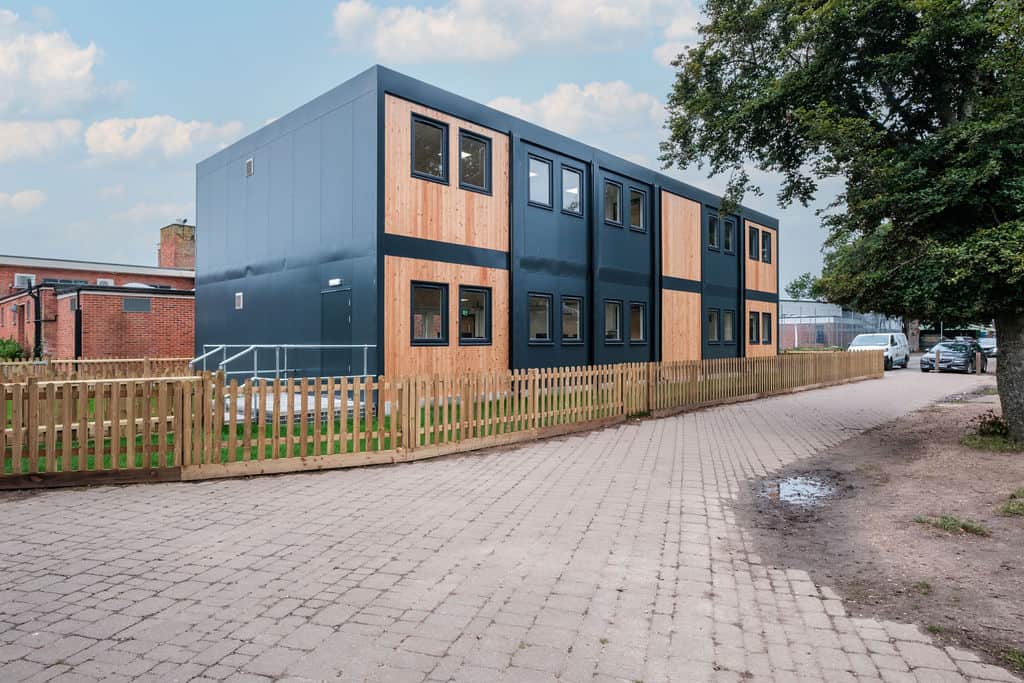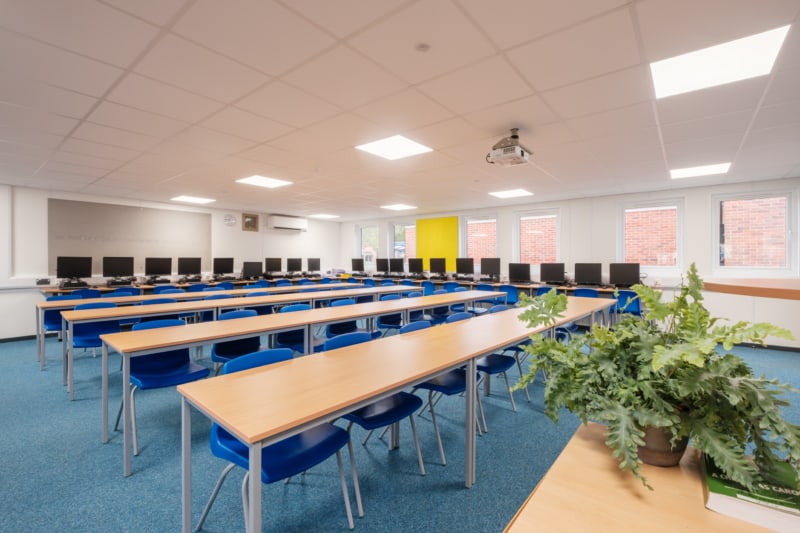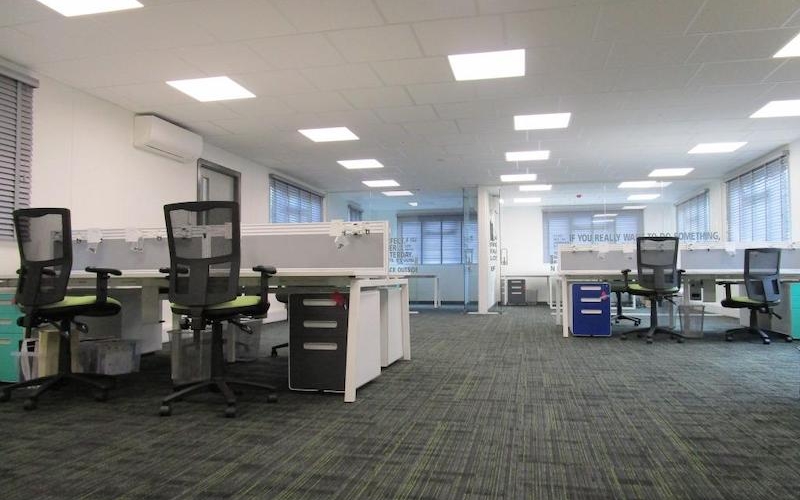26.04.2024• Posts & News
The environmental benefits of modular construction in education

Schools, colleges and universities need to set a good example for the next generation and provide young people with positive role models. A large part of this is understanding that we only have one planet and everyone plays a role in protecting its future. That’s why PF Modular is here to provide modular school buildings that are designed with sustainability at their core.
In this blog, we’re taking a look at the many ways that our modular buildings and the installation process are designed to cut down carbon emissions and protect the environment, which we’re sure you’ll agree is great news for your educational organisation’s green targets and public image.
Reduced environmental impact
Modular construction boasts a significantly reduced environmental impact compared to traditional construction methods. By prefabricating building components off-site in a state-of-the-art factory, modular construction minimises material waste, energy consumption and pollution. This optimised approach to the assembly process also generates less noise and disruption to your site’s surrounding environment, making it a more environmentally friendly option for school construction projects.
Energy efficiency
Energy efficiency is a critical consideration in sustainable building design, particularly in educational facilities where energy consumption can be substantial. Modular construction allows for the integration of energy-efficient features such as high-performance insulation, LED lighting and advanced HVAC systems. These features help to reduce energy usage and lower operating costs over the lifetime of the building.
Your modular classrooms can also be designed to maximise natural light and ventilation, further reducing the need for artificial lighting and air conditioning. By prioritising energy efficiency, educational organisations can create comfortable, healthy learning environments whilst reducing their carbon footprints.
Sustainable materials and waste reduction
Modular construction promotes the use of sustainable materials that minimise harm to the environment and support responsible resource management. An excellent example is the timber used by PF Modular, which is all FSC certified. We also strive to keep material waste down to an absolute minimum, with as much as possible being repurposed or recycled rather than being discarded.
Shorter construction timelines
One of the most significant environmental benefits of modular construction is its shorter construction timelines. By manufacturing building components off-site, modular buildings accelerate the construction process and minimise the duration of on-site activities. This reduction in construction time translates to lower CO2 emissions from construction equipment, fewer vehicles required to carry out the project, reduced energy consumption, and less dust and noise.
Faster construction also means that the community and ecosystems surrounding your site are disturbed as little as possible, which helps to preserve local habitats and biodiversity.

What can modular buildings be used for in the education sector?
To give a feel for just how versatile modular buildings are, here are some popular applications for nurseries, schools, colleges, universities and training centres.
- Classrooms: Modular buildings can be designed and configured however you wish, resulting in bright, welcoming and adaptable teaching spaces.
- Subject-specific environments: From science labs, IT suites and food technology kitchens to art rooms and drama studios, our modular buildings can host a wide range of subjects.
- Libraries: Modular buildings are also a very popular solution for libraries and archives.
- Staff offices: Teachers and non-teaching staff can use our modular buildings as receptions, finance offices, marketing studios, meeting facilities, staff rooms, and anything else that requires a warm, comfortable and secure space.
- Storage: Are your stationery cupboards overcrowded? Is there seasonal sports equipment getting in the way within your gym facilities? Modular buildings are a cost-effective way to create new storage areas for all kinds of equipment.
- Shower and toilet blocks: Modular buildings can be configured and kitted out to all kinds of specifications, which can include the integration of showers, W/Cs, changing areas and locker rooms.
- Catering facilities: If you’re finding that your current dining facilities can’t fit all of your students at once, or if your staff require a separate area for breakfast and lunch, we suggest a modular building designed with built-in catering facilities.
- Bike hubs: As more staff and students cycle to work in order to reduce their carbon emissions and save money, our modular buildings can be designated as secure bike hubs.
We won’t be beaten on price!
Our modular buildings can be used for classrooms, offices and all kinds of applications. What remains consistent is that they’re up to 70% faster to install and up to 50% cheaper than the traditional construction route. This means that you can have a flexible and sustainable modular building ready to use in no time, all while being kind to your budget as well as the planet.
Don’t forget that we offer finance options
We appreciate that budgets can be strict and cash flow is king. That’s why we offer finance agreements to our customers, which are designed to suit your needs. This will help to free up capital and enable you to invest in a modular building right away, rather than having to wait for the next influx of funding or for a new financial year to begin.
If you’re interested in paying for your modular buildings in manageable instalments as opposed to all in one go, get in touch with our team and explore your options.
Read our Sustainability Policy
Now that you’ve read this article, you should have a good idea of how PF Modular helps schools, colleges and universities to choose a sustainable approach to expanding facilities and campuses. To find out more about how we minimise the negative impact of construction projects and contribute to making our industry more ethical and eco-friendly, please take a look at our Sustainability Policy.
Ask us about modular classrooms today
If you’re ready to find out more about how modular buildings will help your educational organisation to improve its sustainability efforts, get in touch with our team of experts on 01420 587880 or through our contact form.
Related Posts

15.07.2024• Cabins, Posts & News
Safety Standards and Best Practices for Portable Office Setups
As businesses grow and the need for versatile workspaces grows, portable cabins offer a flexible, cost-effective solution. Whether businesses need temporary offices or long-term...
Continue Reading
15.07.2024• Posts & News
How Modular Buildings Are Supporting Sustainable Practices in Education
Over the last few years, sustainability has grown from a buzzword to an essential imperative across various sectors, including education. As educators and project...
Continue Reading
14.06.2024• Posts & News
Easily Adapt Your Business Space with a Modular Office
Adaptability and efficiency are essential for businesses wanting to keep up with their competitors. Project managers and business owners are constantly seeking innovative solutions...
Continue Reading